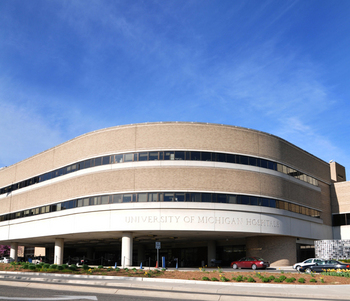The text of the email sent to a University of Michigan Health System staff Thursday afternoon is below.
The email is from Ora H. Pescovitz, U-M executive vice president for medical affairs; Douglas L. Strong, CEO of U-M Hospitals and Health Centers; and James O. Woolliscroft, dean of the U-M medical school.

University of Michigan Hospital in Ann Arbor.
University of Michigan Health System photo
There is much political conversation about the country being at a fiscal cliff - a precipice of tax increases and spending cuts that will occur Jan. 1 unless the federal government gets its financial house in order.
We also find ourselves at a significant crossroad for our Health System, where larger-than-expected deficits now require us to focus intently on ensuring we have a positive margin for this year so that we have a solid foundation to weather expected financial pressures in the years ahead.
Our expenses after the first four months of our current fiscal year, which began July 1, are greatly exceeding our revenue, which leaves us with a much larger than expected financial challenge. Both the Hospitals and Health Centers and the Medical School need to considerably reduce operating expenses for the remainder of this fiscal year to offset this deficit.
One month ago, we asked leaders of each unit of the HHC and each academic and administrative area of the Medical School to consider how best to reduce expenses. The approaches were different for those two parts of our Health System, given how different the business and operations are for each.
HHC leaders were asked to develop detailed expense management plans to adjust to new revenue realities. Those plans included attrition management; reductions in appointment effort, overtime, temporary staff and contract labor; and savings from improvements in supply chain efforts.
In the Medical School, each of the departments underwent a “stress test” by looking at expenses should there be an additional 10 percent reduction in revenue to each unit. Each of the department leadership teams considered hard choices about what programs and projects could be reduced or cut to remain solvent, including support for unfunded research and targeting clinical areas where revenue could be enhanced. The Faculty Group Practice asked each of the Ambulatory Care medical directors to bring their margin back to at least the level of FY12; their detailed plans exceeded this goal.
All of our leaders have responded with plans that will significantly reduce our negative margin. But more work remains. We have not closed the gap between our expenses and our revenue for this fiscal year, and our challenges moving forward are growing.
By the end of the decade, the Health System may be facing a $200 million annual gap in our clinical margin. In the Medical School, the challenge to secure research funding will continue. The fiscal pressures on our federal and state governments are very real, and the actions taken by government will hit our Health System - and all hospitals and medical schools - hard.
Across-the-board cuts to reduce the federal budget deficit (also known as budget sequestration), could be the path our legislators take. If this happens, we will see a decrease in National Institutes of Health and medical education funding, potentially significant reductions in payments for hospital outpatient services and decreases in physician reimbursement.
These external forces make it more important than ever that we take meaningful and sustainable actions now to improve our operations and financial performance to prepare us for the financial pressures that will continue. The work we do now to create a positive margin for this fiscal year is the first phase of our cost-reduction efforts and will position us well, but we know that we must continue to look for more ways to improve processes, throughput and efficiency across our Health System, as we are doing through reductions in length of stay, improving capacity and access, expense management and revenue growth. In research, we are consolidating service contracts to reduce expenses, streamlining repairs to laboratory equipment and are using lean thinking to reduce the post-award management of externally-sponsored research.
Our strategic plan continues to be our roadmap: a combination of investing in growth in key areas and recognizing what we must stop doing to help improve our operating performance. Our rich history, excellence across each part of our mission and abundant assets afford us an opportunity that few other academic medical centers have to weather this period of financial uncertainty. But it will require diligence, hard work and undeterred focus to ensure we never stop seeking ways to improve.
We are committed to moving our Health System forward - strategically, strongly and effectively. We appreciate all you are doing to ensure The Michigan Difference continues to be more than words, but the palpable result of our commitment each day to make a lasting impression on all who come here for care, research and education.
Ora H. Pescovitz, M.D.
Executive Vice President for Medical Affairs, U-M CEO, U-M Health System
Douglas L. Strong
CEO, University of Michigan Hospitals and Health Centers
James O. Woolliscroft, M.D.
Dean, Medical School
Lyle C. Roll Professor of Medicine